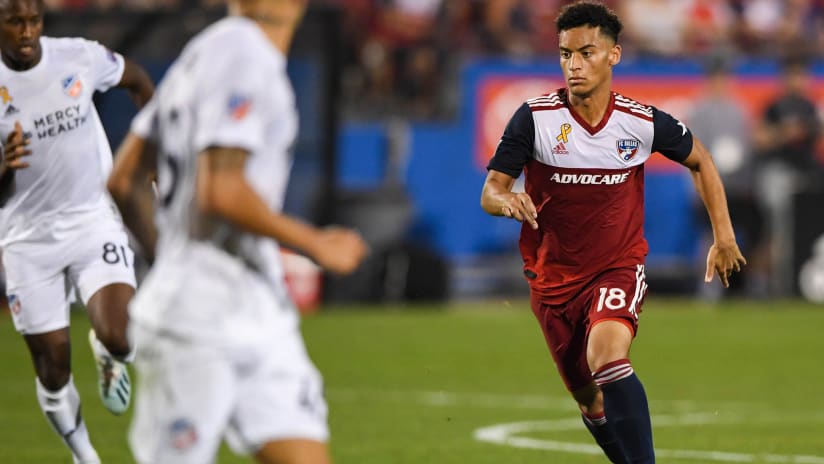With six games remaining in the regular season, the attention is shifting toward FC Cincinnati’s future. And right on cue, the first official FCC Academy matches are this weekend in Minnesota.
But the future doesn’t rest on wins and losses for both the first team and two academy sides. It rests on development. Development of the first-team roster, development of the Academy and development of a club philosophy.
And if you need an example for what development looks like, perhaps the best example was the club that beat Cincinnati this past weekend in Frisco, Texas.
FCC suffered a 3-1 defeat to FC Dallas last Saturday in a match, essentially after conceding two goals two minutes apart in the second half. The significance of this isn’t how they lost, but instead whom the Orange and Blue lost against.
The short answer is a lot of “kids.”
FC Dallas used six MLS Homegrowns against Cincinnati. These are players who specifically came through the FC Dallas Academy, earned professional contracts and are now professional players.
Victor Ulloa was the second-ever FCD Homegrown. As of June 24, FCD have signed 26 players from their academy. In late September 2016, they had 15.
Essentially, the North Texas club has developed a pathway for young local kids that leads to first-team opportunities – and, speaking in a broader context – has helped changed the present and future of American soccer.
FCD is a club that’s become synonymous with the #PlayYourKids Movement.
It’s a belief that the quickest way to develop players and MLS alike is by playing young players and providing opportunities previously unavailable or ignored.
At FC Cincinnati, that would mean playing Frankie Amaya and other 2019 MLS SuperDraft rookies. (After Saturday’s loss, Head Coach Ron Jans said he plans to do that.)
Against Cincinnati, Dallas played had eight available Homegrowns (two were unused on the bench). The oldest HG was goalkeeper Jesse Gonzalez at 24. Ricardo Pepi, who was a late sub, is only 16.
Here are the ages of the HGs who played against FCC:
Gonzalez: 24
Pepi: 16
Jesus Ferreira: 18
Paxton Pomykal: 19
Brandon Servania: 18
Reggie Cannon: 21
Beginning with the U.S. Under-17 National Team and progressing toward the senior team, of all players currently in the United States’ national team camp ahead of this weekend’s friendlies against Mexico and Uruguay, 13 have come through the FCD Academy at some point, including Weston McKennie, who’s now at Schalke in the German Bundesliga.
Gonzalez, Cannon and Pomykal were recently called into the U.S. Men’s National Team squad and could play Friday night against Mexico. For Cannon, this is an extension from his use as right back for the U.S. in 2019 Concacaf Gold Cup.
This is more than #PlayYourKids, however. This is developing a pathway, establishing a club philosophy and changing the game – literally.
How does one academy produce so many talented players at such a fast rate?
With this in mind, I spoke with Chris Hayden, the FCD Academy Director, on Friday afternoon to discuss what Dallas does specifically that’s been so successful.
“It’s like a swan on top of the water with feet paddling underneath and no one said it,” Hayden said, ironically during a thunderstorm with so much rain a swan could’ve swam inside Toyota Stadium with a few more hours of the downpour.
“We’ve been working for a long time with a similar vision. So, I think we’ve given ourselves a chance to get better. In that evolution, we really haven’t changed course. Year over year, we’ve made small improvements. When you look back over time, over 12 years now that we’ve had the academy, I think we’ve made huge, huge strides and we’re not the same club that we were then.”
The FC Dallas Academy is a vast one. There are more than 250 teams for boys and girls, and there are affiliates, too. Outside of Hayden’s office, which is inside Toyota Stadium, there are 17 practice fields. There are another 15 fields elsewhere.
Hayden himself just got back from Germany, where he was coaching players against Bayern Munich. (FCD and Bayern have a partnership.) The U-9 and U-10 teams recently went to play in Spain. The U-11s went to Brazil.
There are thousands of kids representing the Dallas academy literally around the world. That’s not something that happened randomly. It developed during a process, and one that’s quite simple in theory but difficult in execution.
FC Dallas have an ownership group that supports young players developing into first-team players. While that leads to growing the local talent pool of players, it also means a business opportunity to sell players to other clubs and generate a profit. There are major incentives of having MLS Homegrowns on your league roster, too.
The team also has a USL League One side that tops the third-division standings and will more than likely win the league. More importantly, that side is comprised of young players who will be the FC Dallas future.
While FCD aren’t the only club doing this, they’re one of the best in America, and doing it well.
So, as the FC Cincinnati Academy begin their first round of matches this weekend, it’s important to remember the results won’t matter. What matters is growing and developing.
There was a time when the FC Dallas Academy didn’t exist. Now, it’s the benchmark. There was also a time in recent history when the FC Cincinnati Academy didn’t exist. The goal – and the current excitement – is to see what happens next.




